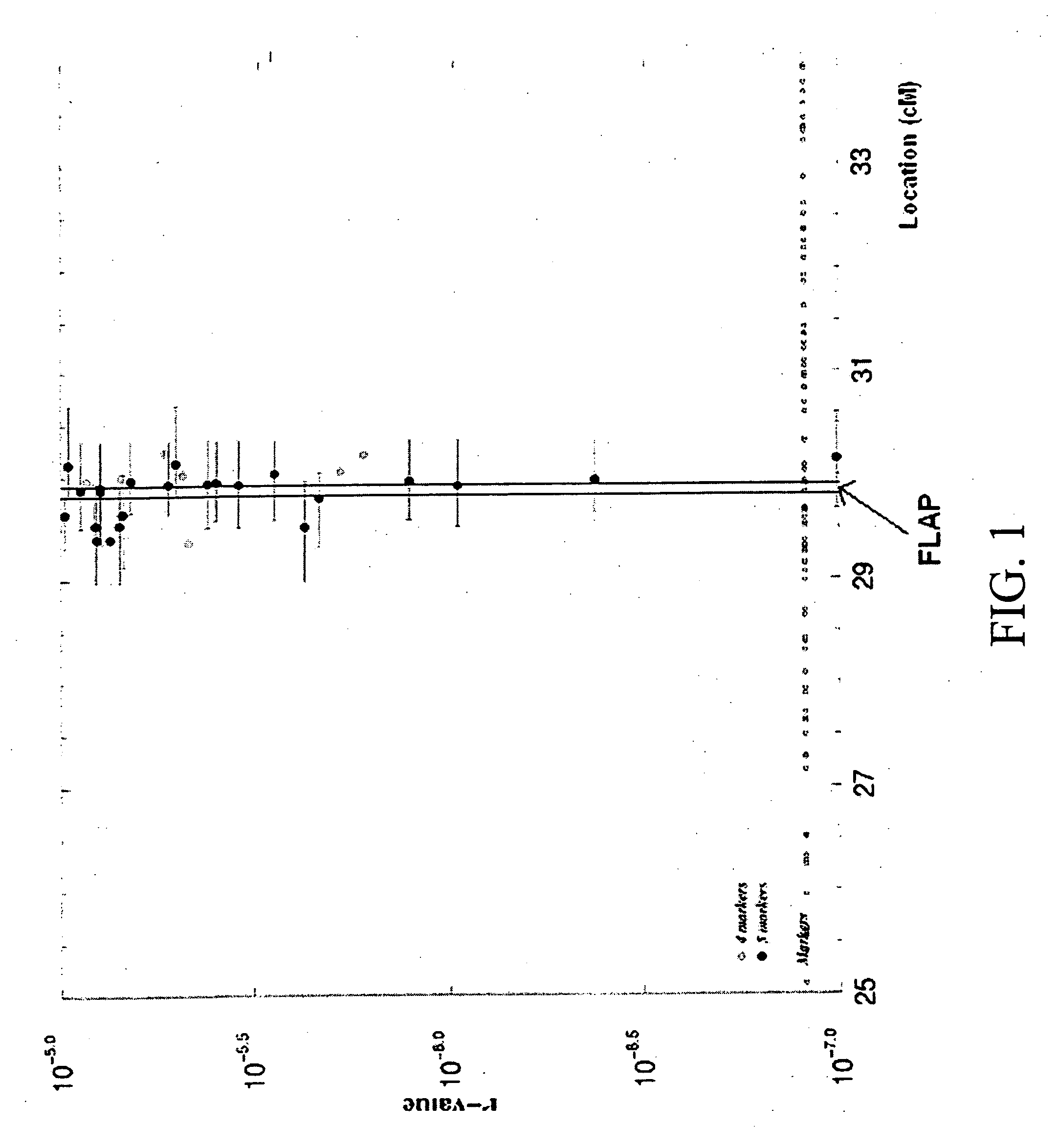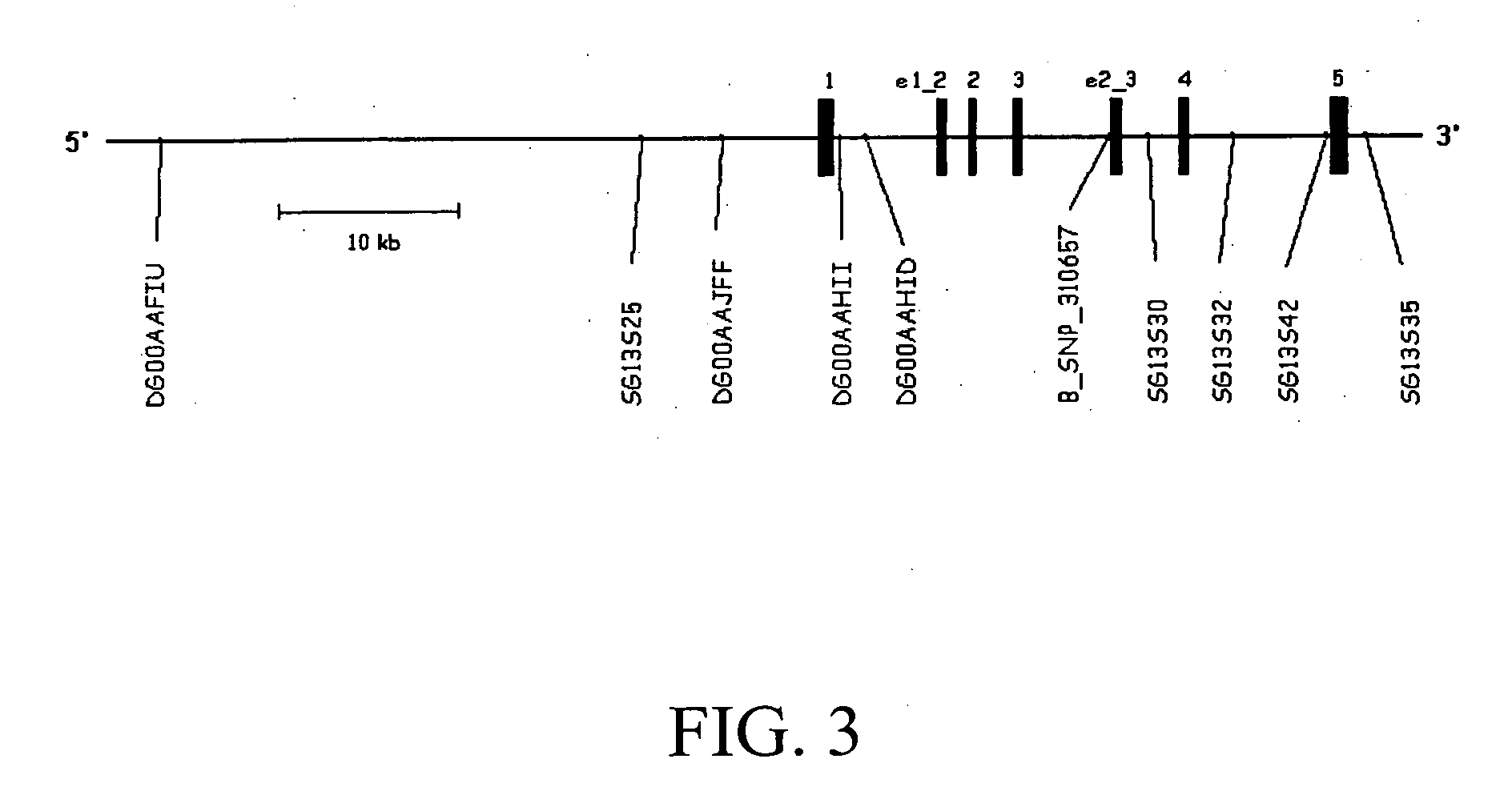Susceptibility gene for myocardial infarction, stroke, and PAOD, methods of treatment
a myocardial infarction and susceptibility gene technology, applied in the field of susceptibility gene for myocardial infarction, stroke, and paod, methods of treatment, can solve the problems of compromising the blood flow to the heart, coronary arterial lumen can become gradually narrowed, and high morbidity and mortality,
- Summary
- Abstract
- Description
- Claims
- Application Information
AI Technical Summary
Benefits of technology
Problems solved by technology
Method used
Image
Examples
example 1
Identification of Gene and Haplotypes Associated With MI
[0295] A genome wide scan of 296 multiplex Icelandic families with 713 MI patients was performed. Through the suggestive linkage to a locus on chromosome 13q12-13 for female MI patients and early onset MI patients, and haplotype association analysis, the gene encoding the 5-lipoxygenase activating protein (FLAP) was identified, and a 4-SNP haplotype within the gene was determined to confer a near 2-fold risk of MI. Male patients showed strongest association to the at-risk haplotype. Independent confirmation of FLAP association to MI was obtained in a British cohort of patients with sporadic MI. These findings support FLAP as the first specific gene isolated that confers substantial risk of the complex trait of MI.
Methods
[0296] Study Population
[0297] Patients entering the study were recruited from a registry that includes all MIs that occurred before the age of 75 (over 8,000 patients) in Iceland from 1981 to 2000. This regi...
example 2
Relationship Between Polymorphism in the 5-Lipoxygenase Promoter and MI
[0336] A family of mutations in the G-C rich transcription factor binding region of the 5-LO gene has previously been identified. These mutations consist of deletion of one, deletion of two, or addition of one zinc finger (Sp1 / Egr-1) binding sites in the region 176 to 147 bp upstream from the ATG translation start site where there are normally 5 Sp1 binding motifs in tandem. These naturally occurring mutations in the human 5-LO gene promoter have been shown to modify transcription factor binding and reporter gene transcription. The capacity of the mutant forms of DNA to promote transcription of CAT reporter constructs have been shown to be significantly less than that of the wild type DNA (J. Clin. Invest. Volume 99, Number 5, March 1997, 1130-1137).
[0337] To test whether 5-LO is associated with the atherosclerotic diseases, particularly myocardial infarction (MI) in the human population, this promoter polymorp...
example 3
Elevated LTE4 Biosynthesis in Individuals with the Flap MI-Risk Haplotype
[0339] Based on the known function of the end products of the leukotriene pathway and based on our 5-LO association data, the association of the FLAP haplotype with MI is best explained by increased expression and / or increased function of the FLAP gene. In other words, those individuals that have a “at risk” FLAP haplotype have either, or both, increased amount of FLAP, or more active FLAP. This would lead to increased production of leukotrienes in these individuals.
[0340] To demonstrate this theory, LTE4, a downstream leukotriene metabolite, was measured in patient serum samples. A quantitative determination of LTE4 in human serum was performed by liquid chromatography coupled with tandem mass spectrometry. The protocol was performed as follows:
[0341] Analytical Method
TABLE P1(Protocol 1): List of AbbreviationsCANAcetonitrileISInternal standardLC-MS / MSLiquid chromatography tandem mass spectrometryLOQLimit...
PUM
| Property | Measurement | Unit |
|---|---|---|
| Volume | aaaaa | aaaaa |
| Volume | aaaaa | aaaaa |
| Volume | aaaaa | aaaaa |
Abstract
Description
Claims
Application Information
 Login to View More
Login to View More - R&D
- Intellectual Property
- Life Sciences
- Materials
- Tech Scout
- Unparalleled Data Quality
- Higher Quality Content
- 60% Fewer Hallucinations
Browse by: Latest US Patents, China's latest patents, Technical Efficacy Thesaurus, Application Domain, Technology Topic, Popular Technical Reports.
© 2025 PatSnap. All rights reserved.Legal|Privacy policy|Modern Slavery Act Transparency Statement|Sitemap|About US| Contact US: help@patsnap.com



